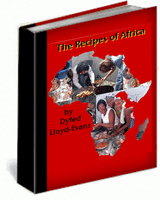Cook's Alphabet 'V'
This is the twenty-second in my series of 28 postings going through the entire alphabet, as it relates to cooks and cooking. As you can see, today I'm dealing with the letter 'V'.
The letter 'V' is, of course the twenty-second letter in the English alphabet and stands for the meat, venison, around which today's recipe is based:
Venison Paprikash
Ingredients:
900g venison haunch cubed
2 tbsp bacon fat
1 onion, chopped
3 garlic cloves, chopped
1/2 tsp salt (or to taste)
1 tsp chilli flakes
3 tbsp paprika
250ml water
400g tinned, chopped, tomatoes, drained (reserve the juice)
2 tbsp plain flour
250ml sour cream
3 tbsp freshly-chopped parsley
Method:
Melt the bacon fat in a large pan or heat-proof casserole over medium heat and use to fry the onion, garlic, salt, chillies and paprika until the onions become translucent (about 6 minutes). Add the venison and fry for about 3 minutes per side and pour in the water. Stir to combine, bring to a boil then cover and reduce to a simmer.
Continue coking for about 80 minutes (adding more water as necessary), or until the pork is tender. Add the tomatoes and continue cooking. In the meanwhile, whisk the tomato juice, flour and sour cram to a smooth paste and slowly add this to the stew, stirring constantly. Continue cooking for about 20 minutes, or until the mixture is thick.
Transfer to a serving bowl, garnish with the parsley and serve accompanied by rice or noodles.
(This recipe reproduced, with permission, from the Celtnet Venison Paprikash Recipe page, which is presented as part of the site's British recipes collection. )
Today's cooking term is Verjus: Verjus, also known as verjuice (literally 'green juice') is a sour juice made from sour grapes, crab apples or other unripe fruit. It was used a great deal in medieval European cookery and is undergoing a revival. It's used as a flavouring in certain condiments, and in cooking can be used in place of lemon juice and vinegar. The term 'green' in the name refers to the uncooked nature of the juice rather than its colour (vinegar, in contrast, as it is soured by fermentation is considered to be 'cooked').
Today's spice is Vanilla: Vanilla represents the pods of orchids in the genus Vanilla. There are about 110 species in this genus, of which Vanilla planifolia is used to derive the spice. This is a vine growing to more than 35m in length, with alternate leaves spread along its length. The short, oblong, dark green leaves of the Vanilla are thick and leathery and each node produces long and strong aerial roots. Short-lived flowers arise successively on short peduncles from the leaf axils or scales. There may be up to 100 flowers on a single raceme, but usually no more than 20. The flowers are quite large and attractive with white, green, greenish yellow or cream colors. Each flower opens up in the morning and closes late in the afternoon, never to re-open. If pollinated, these mature to form the fruit (vanilla pod) which is an elongate, fleshy seed pod 10—20 cm long. It ripens gradually (8 to 9 months after flowering), eventually turning black in color and giving off a strong aroma. Each pod contains thousands of minute seeds, but it is the pod that is used to create commercial vanilla flavouring. Though most of the species in the genus Vanilla produce flavoursome pods, only Vanilla planifolia is used for industrial purposes.
As a spice vanilla comes either as the whole bean, vanilla powder or vanilla extract (this is an extract produced by dripping alchohol on split vanilla pods). Vanilla is highly fragrant with an exotic aroma. Vanilla is extensively used throughout the world in foods, confectionary, pharmaceuticals and beverages. Used almost exclusively in sweet cookery, vanilla is added to cakes, biscuits, puddings and desserts. However, in certain cuisines (Réunion cookery being notable) vanilla is used extensively in savoury dishes as well. Below is a recipe for a classic British dish of plums baked with vanilla:
Vanilla-baked Plum
Ingredients:
1kg flavoursome plums
3 vanilla pods, split and with seeds removed
1 glass vin santo
500g sugar
Method:
Arrange the plums in a roasting tray. Split the vanilla pods and scrape the seeds into the vin santo. Scatter the empty pods over the plums then stir the wine to make sure the vanilla seeds are evenly distributed before pouring over the plums. Scatter the sugar over the top, cover with greaseproof paper and then with a layer of aluminium foil (make certain to tuck this over the edges of the tray. Place in an oven pre-heated to 150°C for 45 minutes. Allow to cool a little before serving with cream or ice cream.
(This recipe reproduced, with permission, from the Celtnet Vanilla-baked Plum Recipe page. )
For more information on cookery-associated terms and information beginning with the letter 'V' here are various links that may well be of interest:
Recipes beginning with 'V'
Spices beginning with 'V'
Herbs beginning with 'V'
Wild foods beginning with 'V'
Cook's glossary 'V'









